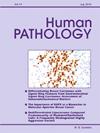PAX6 is a useful marker for pancreatic origin of neuroendocrine neoplasms: A tissue microarray study evaluating more than 19,000 tumors from 150 different tumor types
IF 2.7
2区 医学
Q2 PATHOLOGY
引用次数: 0
Abstract
PAX6 immunohistochemistry (IHC) was proposed as a tool to identify a pancreatic origin of neuroendocrine neoplasms (NENs). To evaluate the diagnostic utility of PAX6 IHC, a tissue microarray containing 19,214 samples from 150 tumor types was analyzed. Data on progesterone receptor (PR) and glutamate decarboxylase 2 (GAD2) expression were available from previous studies. PAX6 staining occurred in 2.6% of 17,224 analyzable tumors and 60 tumor categories showed PAX6 positivity in at least one case. The highest rates of PAX6 positivity occurred in pancreatic (42.9–70.8%) and other NENs (up to 50.0%), testicular tumors (up to 58.3%), basal cell carcinomas of the skin (51.9%), squamous cell carcinomas of different organs (1.5–11.8%), and in gynecological tumors (up to 30%). For detection of pancreatic origin of NENs, sensitivity was highest for PAX6 (68.7%) followed by GAD2 (62.6%) and PR (52.5%) while specificity was highest for GAD2 (95.2%), followed by PR (91.3%), and PAX6 (91.1%). Of the analyzed combinations, the highest sensitivity (53.8%) and specificity (100%) was found for PAX6/GAD2, although combinations of PAX6/PR (49.5%/99.3%), PR/GAD2 (40.7%/98.9%), and PAX6/PR/GAD2 (40.6%/100%) did also result in high specificity. Only 14% of the 118 NENs with negativity for all three antibodies were of pancreatic origin. It is concluded that PAX6 IHC is useful to identify a pancreatic origin in case of NEN metastases of unknown origin. The combination with GAD2 and PR further increase the diagnostic performance of PAX6 and results in a >98% specificity in case of positivity for at least 2 of these markers.
PAX6 是神经内分泌肿瘤胰腺起源的有效标记物:一项组织芯片研究评估了来自 150 种不同肿瘤类型的 19,000 多例肿瘤。
PAX6 免疫组织化学(IHC)被认为是鉴别神经内分泌肿瘤(NENs)胰腺来源的一种工具。为了评估 PAX6 IHC 的诊断效用,我们分析了一个包含来自 150 种肿瘤类型的 19,214 个样本的组织芯片。之前的研究提供了有关孕酮受体(PR)和谷氨酸脱羧酶 2(GAD2)表达的数据。在 17,224 例可分析的肿瘤中,2.6% 的肿瘤出现了 PAX6 染色,60 种肿瘤至少有一例出现 PAX6 阳性。PAX6 阳性率最高的是胰腺肿瘤(42.9%-70.8%)和其他 NENs(高达 50.0%)、睾丸肿瘤(高达 58.3%)、皮肤基底细胞癌(51.9%)、不同器官的鳞状细胞癌(1.5%-11.8%)以及妇科肿瘤(高达 30%)。在检测胰腺来源的 NEN 时,PAX6 的灵敏度最高(68.7%),其次是 GAD2(62.6%)和 PR(52.5%),而 GAD2 的特异性最高(95.2%),其次是 PR(91.3%)和 PAX6(91.1%)。在分析的组合中,PAX6/GAD2 的灵敏度(53.8%)和特异度(100%)最高,尽管 PAX6/PR(49.5%/99.3%)、PR/GAD2(40.7%/98.9%)和 PAX6/PR/GAD2(40.6%/100%)的组合也能产生较高的特异度。在三种抗体均呈阴性的 118 例 NENs 中,只有 14% 是胰腺源性的。结论是,PAX6 IHC有助于鉴别来源不明的胰腺网状细胞转移瘤的胰腺来源。与 GAD2 和 PR 联合使用可进一步提高 PAX6 的诊断性能,在至少两种标记物阳性的情况下,特异性大于 98%。
本文章由计算机程序翻译,如有差异,请以英文原文为准。
求助全文
约1分钟内获得全文
求助全文
来源期刊

Human pathology
医学-病理学
CiteScore
5.30
自引率
6.10%
发文量
206
审稿时长
21 days
期刊介绍:
Human Pathology is designed to bring information of clinicopathologic significance to human disease to the laboratory and clinical physician. It presents information drawn from morphologic and clinical laboratory studies with direct relevance to the understanding of human diseases. Papers published concern morphologic and clinicopathologic observations, reviews of diseases, analyses of problems in pathology, significant collections of case material and advances in concepts or techniques of value in the analysis and diagnosis of disease. Theoretical and experimental pathology and molecular biology pertinent to human disease are included. This critical journal is well illustrated with exceptional reproductions of photomicrographs and microscopic anatomy.
 求助内容:
求助内容: 应助结果提醒方式:
应助结果提醒方式:


